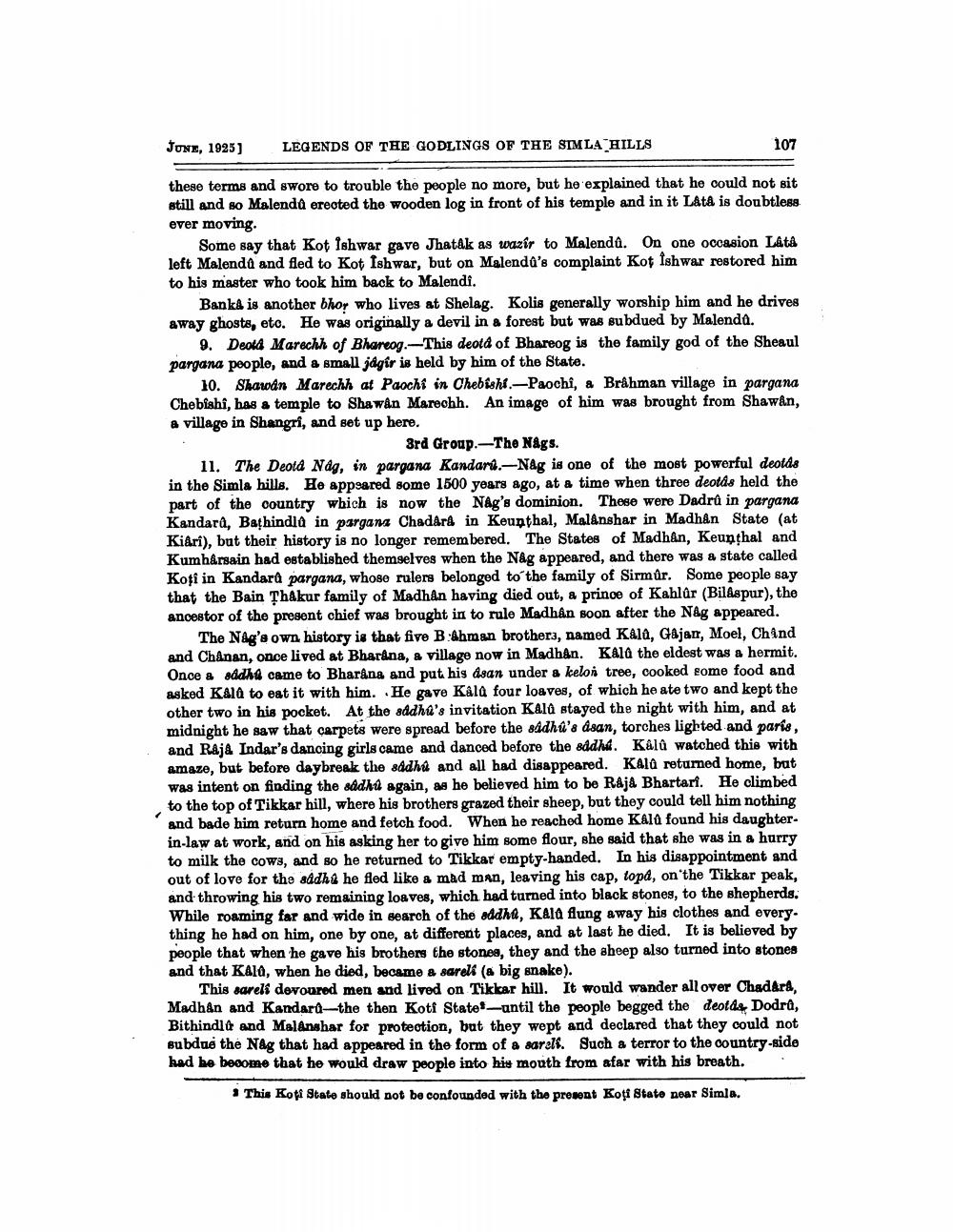________________
JONE, 1925)
LEGENDS OF THE GODLINGS OF THE SIM LA HILLS
107
these terms and swore to trouble the people no more, but he explained that he could not sit still and so Malendû erected the wooden log in front of his temple and in it Latå is doubtless ever moving.
Some say that Kot Ishwar gave Jhatak as wazir to Malendů. On one occasion Lata left Malendû and fled to Kot Ishwar, but on Malenda's complaint Kot Ishwar restored him to his master who took him back to Malendi.
BankA is another bhor who lives at Shelag. Kolis generally worship him and he drives away ghosts, eto. He was originally a devil in a forest but was subdued by Malenda.
9. Deotd Marechh of Bhareog.-This deotd of Bhareog is the family god of the Sheaul pargana people, and a small jagîr is held by him of the State.
10. Shawan Marechh at Paochi in Chebishi.-Paochi, a Brahman village in pargana Chebishi, has a temple to Shawan Marechh. An image of him was brought from Shawan, a village in Shangri, and set up here.
3rd Group.-The Nags. 11. The Deota Ndg, in pargana Kandart.-Nag is one of the most powerful deolds in the Simla hills. He appeared some 1500 years ago, at a time when three deotás held the part of the country which is now the Nag's dominion. These were Dadru in pargana Kandard, Bathindla in pargan Chadara in Keunthal, Malanshar in Madhan State (at Kiári), but their history is no longer remembered. The States of Madhân, Keunthal and Kumhårsain had established themselves when the Någ appeared, and there was a state called Koti in Kandard pargana, whose rulers belonged to the family of Sirmûr. Some people say that the Bain Thakur family of Madhan having died out, a prince of Kahlûr (BilAspur), the ancestor of the present chief was brought in to rule Madhân soon after the Nag appeared.
The Nag's own history is that five Bahman brothers, named Kala, Gajarr, Moel, Chind and Chanan, onoe lived at Bharana, a village now in Madhan. Kala the eldest was a hermit. Once & addha came to Bharâns and put his asan under a keloi tree, cooked some food and asked Kald to eat it with him. He gave Kâld four loaves, of which he ate two and kept the other two in his pocket. At the addha's invitation Kald stayed the night with him, and at midnight he saw that carpets were spread before the sadhu'a dsan, torches lighted and paris, and Raja Indar's dancing girls came and danced before the addha Kala watched this with amaze, but before daybreak the addhit and all had disappeared. Kald returned home, but was intent on finding the addhi again, as he believed him to be Raja Bhartarf. He climbed to the top of Tikkar hill, where his brothers grazed their sheep, but they could tell him nothing and bade him return home and fetch food. When he reached home Kald found his daughter in-law at work, and on his asking her to give him some flour, she said that she was in a hurry to milk the cows, and so he returned to Tikkar empty-handed. In his disappointment and out of love for the addhi he fled like a mad man, leaving his cap, topd, on the Tikkar peak, and throwing his two remaining loaves, which had turned into black stones, to the shepherds. While roaming far and wide in search of the addha, Kala flung away his clothes and every. thing he had on him, one by one, at different places, and at last he died. It is believed by people that when he gave his brothers the stones, they and the sheep also turned into stones and that KALA, when he died, became a sareli (a big snake).
This sareli dovoured men and lived on Tikkar hill. It would wander all over Chadara Madhan and Kandard--the then Kotf State-until the people begged the deotd Dodra, Bithindla and Malanshar for protection, but they wept and declared that they could not subdue the Nag that had appeared in the form of a sorell. Such a terror to the country-side had he become that he would draw people into his mouth from afar with his breath.
* This Koti State should not be confounded with the present Koti Stato near Simle.




